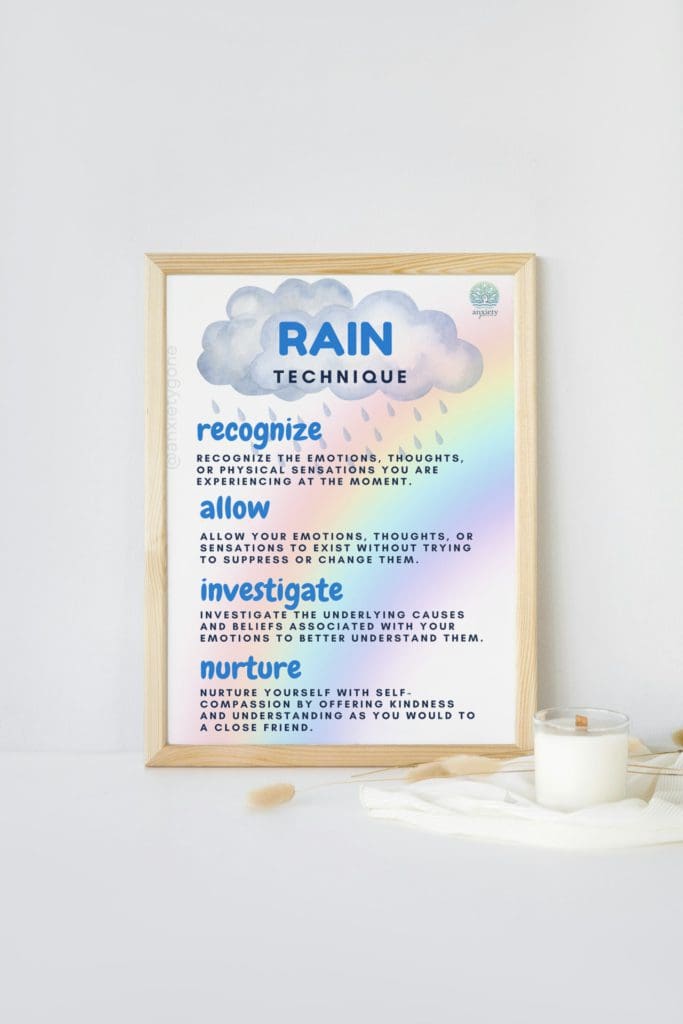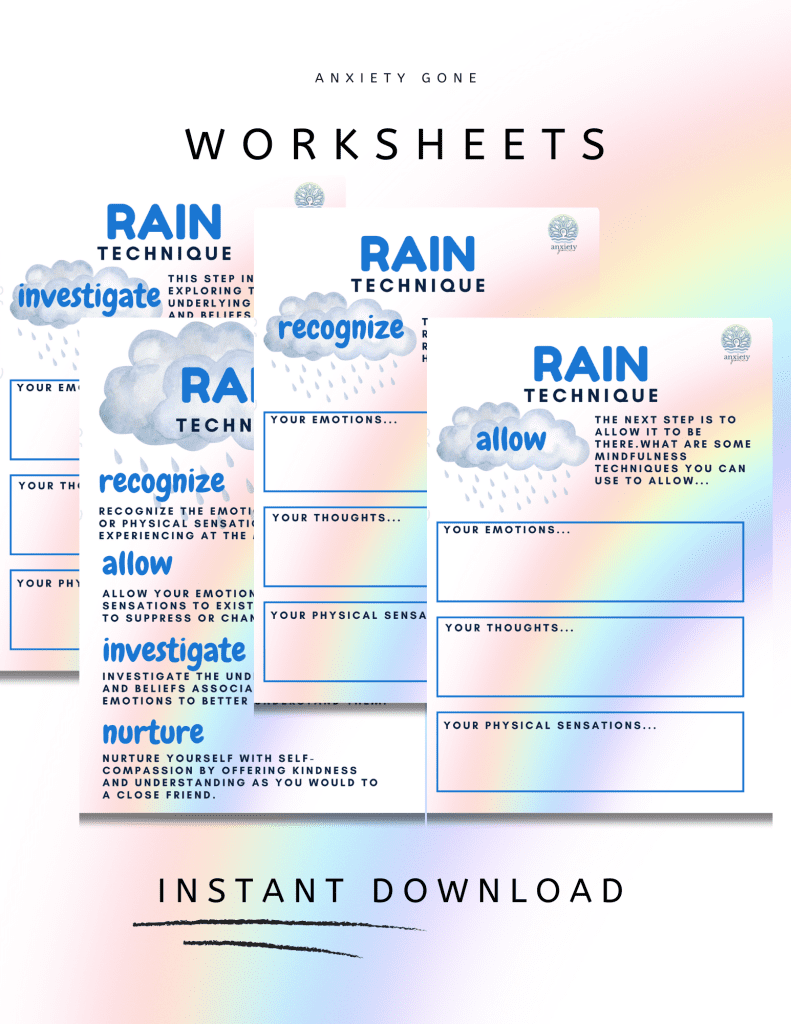Full Disclosure: Clicking on these links could mean a tiny commission for me, at no extra cost to you.
Managing emotions and maintaining your mental health can be challenging on the best of days. Add in a stressful event and it can take things to a whole new level. But that’s why we have coping methods; to help us get through those tough times when our emotions are seemingly getting the best of us. Today, we want to teach you about the RAIN technique, a mindfulness practice that offers a simple yet effective way to navigate emotional turbulence. By recognizing, allowing, investigating, and nurturing your emotions, you can achieve emotional healing and build resilience.
What is the RAIN Technique?
The RAIN technique is a mindfulness-based practice designed to help individuals manage their emotions. Originally developed by mindfulness teacher Michele McDonald, this technique has been popularized by Tara Brach, a psychologist and meditation teacher. The acronym RAIN stands for Recognize, Allow, Investigate, and Nurture. Each step plays a crucial role in transforming our relationship with difficult emotions.
Step 1: Recognize
The first step in the RAIN technique is to recognize what is happening inside us. This involves identifying the emotions, thoughts, or physical sensations we are experiencing at the moment. It’s about being present and aware without judgment.
- Practice Tip: Take a few deep breaths and ask yourself, “What am I feeling right now?” Notice the emotions that arise and label them—fear, anger, sadness, anxiety, etc. Acknowledging these feelings can be the first step towards understanding them.
Step 2: Allow
Once we have recognized our current experience, the next step is to allow it to be there. Allowing means letting our emotions, thoughts, or sensations exist without trying to suppress or change them. It’s about giving ourselves permission to feel what we’re feeling.
- Practice Tip: Instead of saying, “I shouldn’t be feeling this way,” try saying, “It’s okay to feel this.” This acceptance can create a space for healing and reduce the intensity of our emotional responses.
Step 3: Investigate
With a compassionate and curious attitude, we then investigate our internal experience. This step involves exploring the underlying causes and beliefs associated with our emotions. It’s about understanding the deeper layers of our emotional state.
- Practice Tip: Ask yourself questions like, “Why am I feeling this way?” or “What triggered this emotion?” Pay attention to where you feel the emotion in your body and what thoughts accompany it. This introspection can provide valuable insights into our emotional patterns.
Step 4: Nurture
The final step in the RAIN technique is to nurture ourselves with self-compassion. This involves offering kindness and understanding to ourselves as we would to a close friend. Nurturing helps soothe our emotional wounds and promotes healing.
- Practice Tip: Practice self-compassion by placing a hand on your heart and speaking gently to yourself. Phrases like “It’s okay to feel this,” or “I’m here for you,” can be incredibly comforting. Remember that nurturing is about being kind and patient with yourself.
Benefits of the RAIN Technique
Incorporating the RAIN technique into your daily life can have numerous benefits for your mental health and emotional well-being, such as:
- Enhanced Emotional Awareness: By regularly practicing RAIN, you become more attuned to your emotions, which helps in identifying and addressing them before they escalate.
- Reduced Stress and Anxiety: Allowing and nurturing emotions can significantly reduce the stress and anxiety that come from resisting or suppressing feelings.
- Improved Self-Compassion: The nurturing step fosters a kind and compassionate relationship with oneself, which is crucial for overall mental health.
- Better Emotional Regulation: Understanding and investigating emotions leads to better emotional regulation and fewer impulsive reactions.
How to Incorporate RAIN into Daily Life
Apps like Mindfulness and Headspace offer guided meditations that incorporate elements of the RAIN technique, making it easy to add this practice into your self care routine. You can upgrade the Mindfulness app with our exclusive discount or try the Headspace app for free with our 14-day trial.
Additionally, here are some practical tips on how to integrate the RAIN technique into your routine:
- Daily Mindfulness Practice: Set aside a few minutes each day for mindfulness meditation, where you can practice RAIN with whatever emotions arise.
- Emotional Check-ins: Throughout the day, pause and check in with yourself. Use the RAIN technique to process any emotions that come up.
- Journaling: Write about your experiences with the RAIN technique. This can deepen your understanding and provide a record of your emotional journey.
- Compassionate Reminders: Place reminders around your home or workspace to practice self-compassion and nurture your emotions.
Download our RAIN technique worksheets here
By incorporating the RAIN technique into your daily routine, you can develop a more compassionate and mindful relationship with your emotions. This practice not only enhances emotional well-being but also fosters resilience and inner peace. Remember, the journey to emotional healing is a personal one, and the RAIN technique is a valuable tool to support you along the way.
Frequently Asked Questions
- Can the RAIN technique be used for all types of emotions?
Yes, the RAIN technique can be applied to a wide range of emotions, from mild irritation to intense grief. It is a versatile tool that helps in processing and understanding any emotional experience. - How long does it take to see the benefits of the RAIN technique?
The benefits of the RAIN technique can be felt immediately in terms of reduced emotional intensity and increased self-awareness. However, like any mindfulness practice, the long-term benefits accumulate over time with regular practice. - Can I practice the RAIN technique on my own?
Absolutely! While it can be helpful to learn the technique with guidance initially, it is designed to be practiced independently. You can adapt it to fit your personal needs and circumstances. - Is the RAIN technique a form of therapy?
While the RAIN technique is therapeutic, it is not a replacement for professional therapy. It can be a valuable complement to therapy and other mental health practices.











